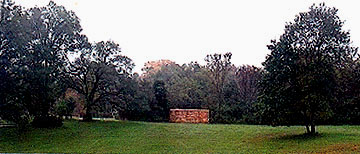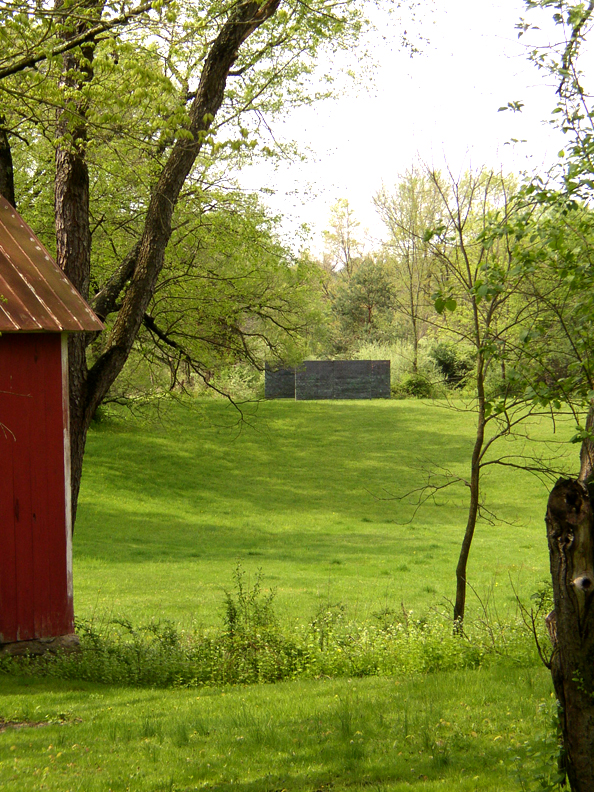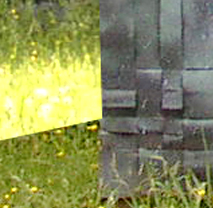In 2009, an international symposium of craftspeople working with metal was held at Peters Valley Craft Center in Layton, New Jersey. Artists from Spain, Poland, Czechoslovakia, Portugal, Scotland and the United States were invited to gather and create work addressing the artist’s relationship to the world around us.
I was asked to present a talk and create with the assistance of the other symposium participants a large, permanent, outdoor sculptural installation. Choosing to speak of Aldo Leopold and design my installation in response to his 1949 book, “A Sand County Almanac," which was influential to my thinking regarding environmental issues.
I envisioned an installation of three hand woven, recycled-scrap copper walls. Weaving each wall on site with the assistance of the other participants each wall would be 120'’ high x 168'’ long x 14" deep. My intent was to demonstrate what Leopold referred to as “land ethic”, a visible reminder of the relationship between people and nature. Copper is a reactive metal. I intended that color changes on the coppers surface, the result of the metals interaction with local pollutants, would provide a visual demonstration of Leopold's "land ethic" philosophy. The more dramatic the color change the greater the degree of pollution.
Leopold wrote, "One of the penalties of an ecological education is that one lives alone in a world of wounds. Much of the damage inflicted on land is quite invisible to laymen. An ecologist must either harden his shell and make believe that the consequences of science are none of his business, or he must be the doctor who sees the unchanged dimensional marks of death in a community that believes itself well and does not want to be told otherwise.” My intent was to make the invisible pollution, visible.
Leopold also wrote that, “A thing is right when it tends to preserve the integrity, stability, and beauty of the biotic community. It is wrong when it tends otherwise,”. Peter's Valley had been plagued for decades by constant, ruinous flooding of its' buildings and property. By careful positioning of each wall on the crest of a centrally located dell, the walls could divert rain water, decrease the flooding and create a new rain garden in the dells' basin again making the invisible, visible.
I was asked to present a talk and create with the assistance of the other symposium participants a large, permanent, outdoor sculptural installation. Choosing to speak of Aldo Leopold and design my installation in response to his 1949 book, “A Sand County Almanac," which was influential to my thinking regarding environmental issues.
I envisioned an installation of three hand woven, recycled-scrap copper walls. Weaving each wall on site with the assistance of the other participants each wall would be 120'’ high x 168'’ long x 14" deep. My intent was to demonstrate what Leopold referred to as “land ethic”, a visible reminder of the relationship between people and nature. Copper is a reactive metal. I intended that color changes on the coppers surface, the result of the metals interaction with local pollutants, would provide a visual demonstration of Leopold's "land ethic" philosophy. The more dramatic the color change the greater the degree of pollution.
Leopold wrote, "One of the penalties of an ecological education is that one lives alone in a world of wounds. Much of the damage inflicted on land is quite invisible to laymen. An ecologist must either harden his shell and make believe that the consequences of science are none of his business, or he must be the doctor who sees the unchanged dimensional marks of death in a community that believes itself well and does not want to be told otherwise.” My intent was to make the invisible pollution, visible.
Leopold also wrote that, “A thing is right when it tends to preserve the integrity, stability, and beauty of the biotic community. It is wrong when it tends otherwise,”. Peter's Valley had been plagued for decades by constant, ruinous flooding of its' buildings and property. By careful positioning of each wall on the crest of a centrally located dell, the walls could divert rain water, decrease the flooding and create a new rain garden in the dells' basin again making the invisible, visible.
-
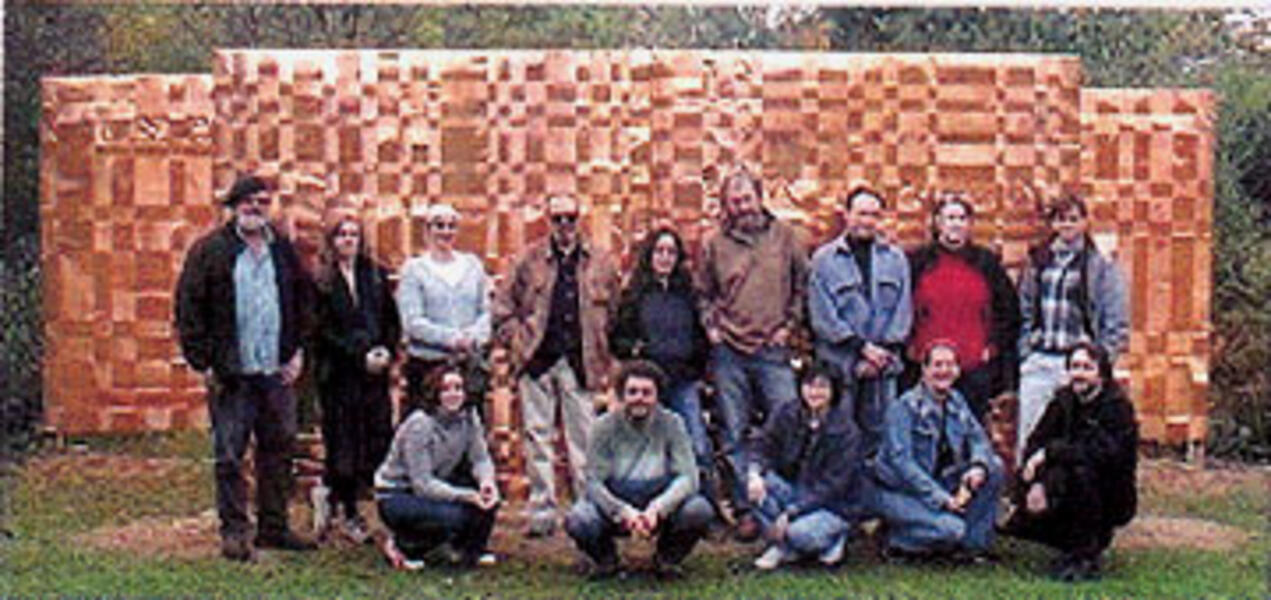 Spring 2009 Wall"Peter's Valley, Leopold Project Wall". Installed at Peters Valley Center during an International Symposium in 2009. Symposium participants, who assisted with the weaving and installation of the walls, pose in front of the completed sculpture.
Spring 2009 Wall"Peter's Valley, Leopold Project Wall". Installed at Peters Valley Center during an International Symposium in 2009. Symposium participants, who assisted with the weaving and installation of the walls, pose in front of the completed sculpture. -
 Fall 2009 Wall"Aldo Leopold Wall Project", fall 2009. Patchy darkening and noted iridescent dichroic, (interference colors), at ground level. Interference colors faded after several weeks as they are composed of free radicals and therefore only loosely adherent. The wall's deeper colors persisted indicating probable sulfidedeposits on the surface. . Possible causes; acid rain, pollution of the surrounding soil, sulphur in the air and anaerobic environment of nearby marshy areas.
Fall 2009 Wall"Aldo Leopold Wall Project", fall 2009. Patchy darkening and noted iridescent dichroic, (interference colors), at ground level. Interference colors faded after several weeks as they are composed of free radicals and therefore only loosely adherent. The wall's deeper colors persisted indicating probable sulfidedeposits on the surface. . Possible causes; acid rain, pollution of the surrounding soil, sulphur in the air and anaerobic environment of nearby marshy areas. -
 Fall 2010One year after installation the wall is showing thick, adherent oxidation that would normally take 3 years to develop.
Fall 2010One year after installation the wall is showing thick, adherent oxidation that would normally take 3 years to develop. -
 Spring 2010Walls exhibit, overall deep adherent patination. Although the acidity of rain in the eastern US is generally high, rain by itself is not sufficient to corrode copper in this manner. This reaction occurs when the acidic residue of rain water remains on a reactive surface; dissolved by dew and other conditions that don't sufficiently dilute the acids or there is a persistent generation of sulfides in the atmosphere causing rapid patination. .
Spring 2010Walls exhibit, overall deep adherent patination. Although the acidity of rain in the eastern US is generally high, rain by itself is not sufficient to corrode copper in this manner. This reaction occurs when the acidic residue of rain water remains on a reactive surface; dissolved by dew and other conditions that don't sufficiently dilute the acids or there is a persistent generation of sulfides in the atmosphere causing rapid patination. . -
 Spring 2011Significant verdigris observed. Probable cause acid rain and/or sulphur dioxide, (common air pollutant) converting to sulfuric acid.
Spring 2011Significant verdigris observed. Probable cause acid rain and/or sulphur dioxide, (common air pollutant) converting to sulfuric acid. -
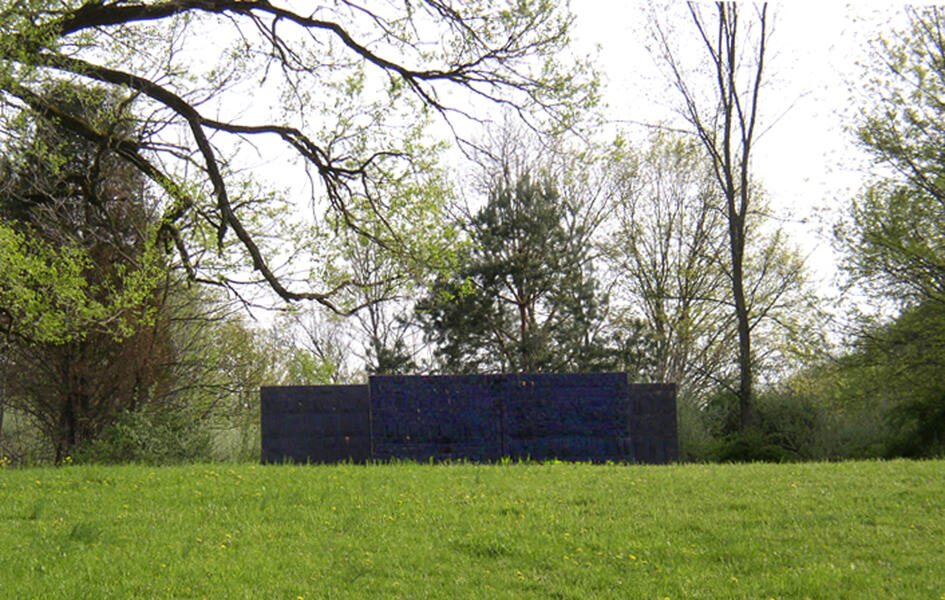 Winter 2012In three years the walls show changes normally seen on the seacoast or a heavily industriallized area after 5-7 years. A visible reminder of Leopold's "land ethic" philosophy
Winter 2012In three years the walls show changes normally seen on the seacoast or a heavily industriallized area after 5-7 years. A visible reminder of Leopold's "land ethic" philosophy

